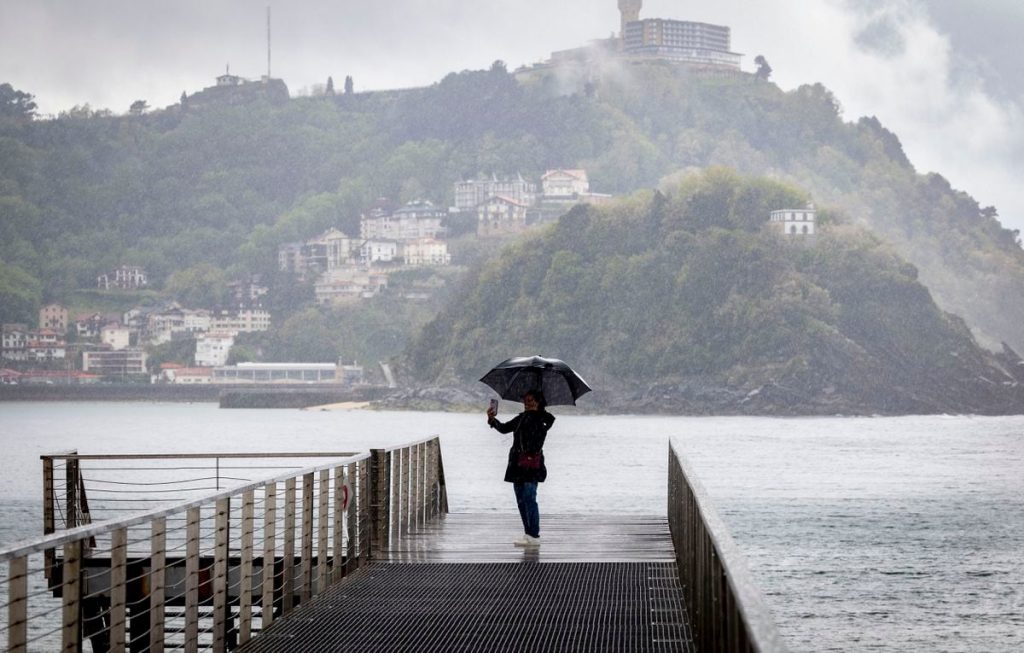After two days of cold temperatures for this time of year, this Wednesday will see a rise in maximum temperatures almost throughout the country, with a more pronounced increase in the northern half, where thermometers will rise by between 6° and 8°. On Thursday, this increase will also affect minimum temperatures, and frosts will be weaker and only in mountainous areas. Both days will be “transitional”, awaiting the arrival of an Atlantic depression, which will bring rain and showers over the weekend to wide areas of the territory, less abundant in the Mediterranean, although on Sunday they could also reach that area. Furthermore, temperatures will drop again and remain somewhat cool, with the possibility of snowfall at relatively low altitudes in the northwest of the Iberian Peninsula, starting at around 1,000 meters.
On Tuesday, the Basque Country, Navarra, La Rioja, and western Aragón experienced daytime temperatures 8° to 10° below normal for late April, with Pamplona reaching just 10°, for example. Nighttime temperatures were also low, with strong frosts in the mountains, especially in the Pyrenees, where it dropped to -11° at over 2,400 meters. “In general, minimum temperatures were between 4° and 7° below normal in much of the north and center of the Peninsula,” details Del Campo. Again this Wednesday, there has been frost in wide areas of the north and center of the Peninsula. In high areas, temperatures have dropped to -10 °C; in populated areas, down to -4 °C. These temperatures are, in many cases, among the 5% coldest recorded for these dates between 1991 and 2020.
This Wednesday also “dawned cold, again hovering around -10° in high areas of the Pyrenees and with frosts in wide areas of the interior of the northern and central regions, somewhat less extensive than on Tuesday, but with -4° in Molina de Aragón and Sigüenza (Guadalajara) and in Burgos. It has frozen in areas near the Catalan coast, such as Girona.” However, it will be “a milder day in the central hours of the day, with over 15° already in much of the northern half and over 20° in the south.” It will only rain, weakly, in the eastern Cantabrian and Western Pyrenees.
On Thursday, cloud cover will increase in most of the country, and morning rain is expected in the Cantabrian region and the Pyrenees, which will spread to the rest of the northern third of the Peninsula and the west, such as the surroundings of the Iberian system, where there could be some thunderstorms. Snow will appear from around 1,200 meters in the northern half, rising in the central hours to 1,500. Nighttime temperatures will rise significantly: up to 5° or 6°. Maximum temperatures will “fall in the northern half and not vary in the south, with Badajoz, Córdoba, Sevilla, and Murcia at 25° or higher.”
The weekend will be stormy. On Saturday, showers are expected in wide areas of the territory, more probable and intense in the Pyrenees, Cantabrian region, northern Castilla y León, Central system, and the Strait. The altitude will range from 1,000 to 1,200 meters in the northwest and from 1,500 to 1,800 in the east. “Some showers are not ruled out on Saturday in parts of the Balearic Islands, and the area that will receive the least rain, if any, will be the southeast–Valencia region, Murcia, and eastern Andalusia,” notes the Aemet spokesperson. Daytime temperatures will drop in much of the country, except in the Mediterranean and eastern Cantabrian regions, where they will rise. Thus, Bilbao will exceed 20° and Valencia and Murcia 25°, while Lugo or León will not reach 15°. Minimum temperatures “will drop in the west and rise in the east.”
On Sunday, it is likely that the depression “will move away towards the British Isles, but unstable weather will continue, with showers in the northern third of the Peninsula, especially in Catalonia and the Balearic Islands, where they could be more intense.” Showers may also occur in other parts of the eastern Peninsula, and cannot be ruled out in the rest of the Peninsula. Nighttime temperatures will be lower, and it could frost in mountainous areas of the north and even in isolated points of the northern plateau and central highlands. Daytime temperatures “will rise, especially in the western Peninsula, but will fall in the Mediterranean and the Balearic Islands.” On Monday, instability is likely to continue in the Mediterranean area, especially in Catalonia, with rain also in other eastern areas of the Peninsula, while on Tuesday a new front could arrive from the northwest. Temperatures will be higher in general at the beginning of the week. In the Canary Islands, the skies will be mostly clear over the next few days, with moderate trade winds blowing from the north and east slopes and breezes on the southern coasts. Temperatures will rise slightly on Wednesday and remain relatively stable until the weekend, when they could drop slightly with the arrival of north winds and increased cloudiness, with rain in the northern, mountainous islands.


